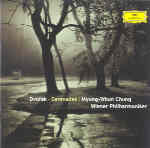It goes without saying that the Vienna Philharmonic’s “scrape section” (as Anna Russell called it) should do nicely by Dvorák’s luscious String Serenade, and so it does. True, Myung-Whun Chung fusses a bit in the first movement’s central section and in the ensuing waltz, but the remainder of the work goes comfortably well, and it’s just so damn pretty that you could play it upside down or under water and it would still give satisfaction. It’s all the more bizarre, then, given his very good previous Dvorák symphony recordings with this orchestra, that Chung comes close to totally ruining the Wind Serenade–and that’s quite an achievement because this is a work that practically plays itself and really doesn’t require a conductor at all.
Chung achieves this debacle simply: he ignores what Dvorák clearly wrote. Take the very first bars of the opening march. Dvorák peppers his score with no less than three kinds of accents (staccatos, sforzandos, and “inverted carrot” heavy stress marks) particularly at the ends of phrases. So what does Chung do? He has his players disregard most of them, making effeminate decrescendos at the end of virtually every phrase, robbing the music of its “military” character and simply wrecking the whole point of its being a march. In the second movement he takes the central presto too quickly, giving the players insufficient time to hit the syncopated rhythms with the necessary force. The slow movement goes well enough, but the finale suffers from the same problems as the opening (that march comes back at the end, you will recall), with tame clarinets in their village band music (listen to that feeble final trill!) and some really excessive ritards going into the slower central section. Really, it would be difficult to conceive of a less idiomatic or characterful approach.
Adding insult to injury, the Vienna winds simply sound “wrong” for the music, and I hasten to add that this has nothing to do with “Czech authenticity” or any such nonsense–witness the reference recordings listed above. For example, the contrabassoon player is listed in the accompanying booklet but he contributes nothing audible to the proceedings. Similarly, those fat, chuffy Viennese horns stand apart from the rest of the ensemble, particularly when playing loudly (at the end), and in general the players work so hard to produce smooth and creamy tones (to sound like strings, in fact) that the dynamics rarely rise above mezzo-forte, the result being that the delightfully fruity character of wind ensemble playing disappears almost entirely. DG’s realistic sonics capture this performance in all of its misconceived glory. If you want both of these works on a single disc, stick with Marriner on Philips, and for either serenade alone there are countless finer options.
































